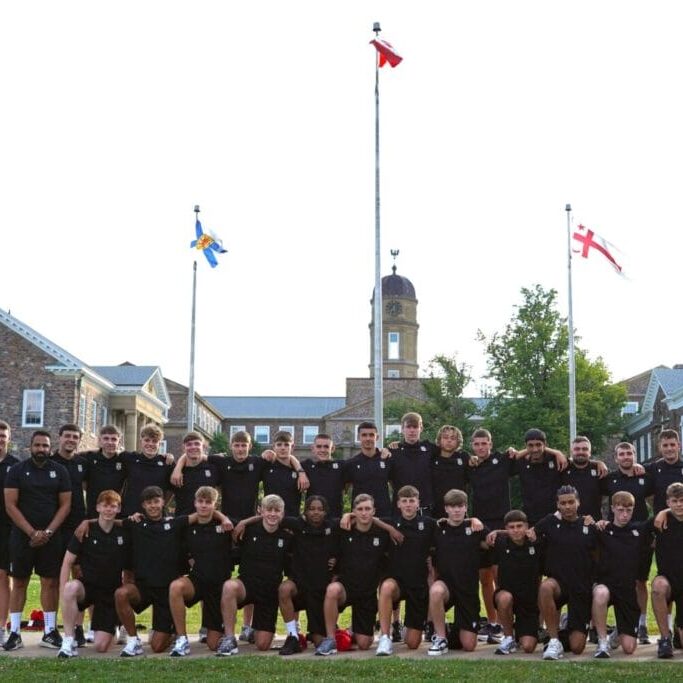
Wrexham AFC U17 and Halifax Tides train at Wickwire Field over the summer
With state-of-the-art facilities and a lack of adequate Canadian soccer training locations, Dalhousie catches eye of top teams
Wrexham AFC and the Halifax Tides have common threads that weave their two soccer clubs together. But this summer, there was more connecting these two than a goal of mass outreach: Dalhousie University.
Welsh football club Wrexham AFC has jumped three divisions in four seasons — that is, league seasons and seasons of its hit docuseries, “Welcome to Wrexham.” While the senior club works to join the Premier League, the U17 club made a leap of its own — across the pond for a series of friendlies against the U21 Halifax Wanderers.
For over a week, the team’s temporary home was LeMarchant Place residence. While on campus, they did strength and conditioning at the Dalplex, board work at Studley Gym and ate together in the meal hall.
Tim Maloney, Dalhousie’s assistant vice-president of athletics, said, “The senior team has obviously become quite famous with their new ownership, so it was pretty cool.”
Dalhousie student and U21 Wanderers player Ben Hashimoto called the experience surreal; over 7,000 fans came to see the Wanderers take on the Ryan Reynolds and Rob McElhenney-owned team. The Wanderers prevailed in the first match, winning 3-0.
Maloney expressed some regret about the Wanderers opting not to renew Dalhousie as its official training grounds, but was thrilled to have the Halifax Tides replacing them.
The Northern Super League is Canada’s first-ever women’s professional soccer league and aims to exponentially grow Canadian women’s soccer — the Tides are one of six teams participating in its inaugural season.
“There’s been tremendous growth and excitement in women’s sport in general,” Maloney said. “But to have a professional women’s soccer team in our hometown is something we felt important to find ways to support.”
The Tides have been using Dalhousie as one of their two training grounds since May, and when the Dalhousie women’s soccer team was still in season, the two teams saw some crossover. Maloney said that Dal women’s players have had the opportunity to train with the Tides, and when Tides players can’t travel due to injury, they get to train with the Dal women’s team.
Maloney also mentioned that the Tides goalie coach has been “very generous with his time,” mentoring one of the new Dal goalie coaches.
“It’s a small thing, but not small at all, for a young new coach to access that level of guidance elevates our own program,” Maloney said.
“What both Wrexham and the Tides highlight is that our programs and facilities go well beyond the day-to-day operations; they are important links to our community both local and beyond — they make Dalhousie a destination.”
Lack of infrastructure
Though the Tides’ sporting director, Amit Batra, said the Dalhousie facilities are excellent, they weren’t left with many choices when choosing training grounds. According to Batra, Canadian soccer infrastructure is dire.
Batra says that a lot goes into training a professional soccer team, and the Tides needed a place where everything its players needed were steps away. The Tides wanted to avoid travelling around the city for different services, as is the case for some other teams in the league.
Batra says that finding a quality field, let alone a comprehensive facility, can be hard. “It’s pretty extreme how old many of these turf fields are, especially if you’re indoors.”
Luckily, Dalhousie checked most of their boxes. Wickwire Field is a pitch designed for soccer — crucial for both player performance and safety — meal services for the athletes and a high-performance training centre, which Batra called “state-of-the-art.”
Batra also said the recovery centres at Dalhousie were a big factor in their search. “A player can come off a game in Vancouver needing a day of recovery and have access to a pool or session,” Batra said.
There were some criteria that Dalhousie couldn’t fill. In the colder months, the Tides must train on indoor turf at the Canadian Sport Institute, around 20 minutes outside the city. Batra also expressed some dissatisfaction with the Studley Gym locker rooms.
“Hopefully we have access to different locker rooms next year, since Studley is kind of old,” Batra said.
Maloney says that talks to renew the contract haven’t begun, but if the Tides were to return, the team would use locker rooms in Dal’s new hockey rink. They would also use the rink’s new physio studio, which will be twice as big as the current space at the Dalplex.






